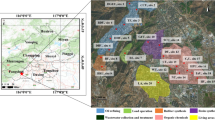Abstract
Volatile organic compounds (VOCs) have been widely concerned as an important precursor of haze. The petrochemical industry not only has many VOC emission sources, but also produces a large amount of VOCs. Although some scholars have analyzed the emission sources of VOCs in the oilfield industry, there still exists the gap in quantitative accounting the emission of organic volatiles from oilfield sewage pools. Moreover, such studies lack certain standardization, accuracy and validity in China. At present, most of the sewage pools in oilfield stations are open-ended. A large amount of VOCs are released into the surrounding environment during the storage of oily wastewater, which has caused serious environmental pollution. In this work, considering six significant influencing factors, a fast VOC emission accounting method from sewage pool in oilfield has been established. To the best of our knowledge, this is the first time to conduct VOC emission quantitative accounting study based on multi-field coupling numerical simulation technology, method of experimental design, and statistical analysis of the response surface methodology. Through comparing the results of numerical simulation with COMSOL, laboratory experiment, and the published literature, the results show that the error is in the range of reasonable, which can satisfy the rapid accounting of VOC emissions from sewage pool in oilfield.











Similar content being viewed by others
Data Availability
Data sharing not applicable to this article as all datasets were generated or analyzed during the current study.
References
Aoki, M., & Iwabuchi, T. (2022). Energy conservation law for weak solutions of the full compressible Navier-Stokes equations. Journal of Differential Equations, 341, 481–503.
Dong, Z., Wang, H., & Zhuang, S. (2018). VOCs emission analysis and emission reduction strategies for storage tanks. Environmental Impact Assessment, 40(6), 16–19.
Feng, Y., Xiao, A., & Jia, R. (2020). Emission characteristics and associated assessment of volatile organic compounds from process units in a refinery. Environmental Pollution, 265, 115026.
Guo, S., Zhou, X., & Tong, L. (2015). Suggestions on improving VOCs control standards from industrial sources. Appraisal Center for Environment & Engineering, 37(2), 41–45.
Hu, J. (2017). Estimation for VOCS emission from a petrochemical enterprise’s wastewater treatment plant and research of self-emission factor. Xuzhou, Jiangsu, China: MA thesis, China University of Mining and Technology.
Huang, M., Fang, Y., Zhao, D., et al. (2017). Research on VOCs monitoring and calculation and circulation water system in petrochemical enterprises. Contemporary Chemical Industry, 46(2), 326–329.
Liu, J., Zhao, J., & Li, T. (2008). Establishment of Chinese anthropogenic source volatile organic compound semission inventory. China Environmental Science, 28(6), 496–500.
Liu Z. (2016). Study on accounting of Volatile organic compounds (VOCs) emissions in refining and chemical enterprises. Qingdao, Shandong, China: MA thesis, China University of Petroleum (East China).
Lu, J. (2017). A study on emission inventory of typical petrochemical plants and its local emission factor. Environmental Pollution and Control, 39(6), 604–609.
Lv, D., Lu, S., Tan, X., et al. (2021a). Source profiles, emission factors and associated contributions to secondary pollution of volatile organic compounds (VOCs) emitted from a local petroleum refinery in Shandong. Environmental Pollution, 274, 116589.
Lv, D., Lu, S., He, S., et al. (2021b). Research on accounting and detection of volatile organic compounds from a typical petroleum refinery in Hebei. North China. Chemosphere, 281, 130653.
Myers, R. H. (1991). Response surface methodology in quality improvement. Communications in Statistics-Theory and Methods, 20(2), 457–476.
Niu, H., Mo, Z., Shao, M., et al. (2016). Screening the emission sources of volatile organic compounds (VOCs) in China by multi-effects evaluation. Frontiers of Environmental Science & Engineering, 10, 1–11.
Paul, M., Charles, T., & Tom, B. (1995). Emission factors for oil and gas operations. API PUBL 4615.
Qu, H., Fu, Y., & Liu, J. (2021). Research on VOCs treatment technology of oily sewage pool in oil field. Journal of Petrochemical Universities, 34(4), 84–90.
Salimon, J., Abdullah, B., & Salih, N. (2012). Selectively increasing of polyunsaturated (18:2) and monounsaturated (18:1) fatty acids in Jatropha curcas seed oil by crystallization using D-optimal design. Chemistry Central Journal, 6, 1–15.
Sun, E., Liu, X., & Lu, M. (2020). Source strength accounting of VOCs from sewage pool in oil field. Environmental Protection of Chemical Industry, 40(1), 212–217.
Tong, X., Zhang, H., Qiu, Q., et al. (2019). VOCs emission calculation for storage TANKS based on tanks model. Environmental Protection of Oil & Gas Fields, 29(1), 48–51.
Tong, R., Yang, Y., Shao, G., et al. (2020). Emission sources and probabilistic health risk of volatile organic compounds emitted from production areas in a petrochemical refinery in Hainan, China. Human and Ecological Risk Assessment: An International Journal, 26(5), 1407–1427.
Wang, F., Chen, J., Zhou, X., et al. (2017). Analysis on estimation method of VOCs loss in organic liquid storage tank in petrochemical industry. Safety Health and Environment, 17(5), 29–33.
Wang, Y., Ji, Z., Xie, Q., et al. (2021). Analysis of factors affecting VOCs emission from oil storage processes. Journal of Environmental Engineering Technology, 11(3), 523–529.
Webb, S. W., & Pruess, K. (2003). The use of Fick’s law for modeling trace gas diffusion in porous media. Transport in Porous Media, 51, 327–341.
Wei, Z., & Wang, H. (2016). Analysis on the characteristics of carbon emissions in Jincheng urea production enterprises. Shanxi Chemical Industry, 36(6), 60–62.
Wong, Y. J., Shiu, H. Y., Chang, J. H. H., et al. (2022). Spatiotemporal impact of COVID-19 on Taiwan air quality in the absence of a lockdown: Influence of urban public transportation use and meteorological conditions. Journal of Cleaner Production, 365, 132893.
Wong, Y. J., Yeganeh, A., Chia, M. Y., et al. (2023). Quantification of COVID-19 impacts on NO2 and O3: Systematic model selection and hyperparameter optimization on AI-based meteorological-normalization methods. Atmospheric Environment, 301, 119677.
Xu, M., Luo, J., & Zhuang, Z. (2021). Research and accounting of VOCs emissions from key industrial sources in a city. International Conference on Smart Transportation and City Engineering 2021. SPIE, 12050, 834–838.
Zhang, J. (2012). Dynamic diffusion process simulation of Fick’s second law based on VTK. Application of Computer Systems, 21(12), 117–120.
Zheng, L., Zhao, D., Lu, L., et al. (2016). The application of leak detection and repair technology in light olefin separation unit of coal chemical industries. Safety Health and Environment, 16(11), 31–34.
Author information
Authors and Affiliations
Corresponding author
Ethics declarations
Competing Interests
The authors declare no competing interests.
Additional information
Publisher's Note
Springer Nature remains neutral with regard to jurisdictional claims in published maps and institutional affiliations.
Rights and permissions
Springer Nature or its licensor (e.g. a society or other partner) holds exclusive rights to this article under a publishing agreement with the author(s) or other rightsholder(s); author self-archiving of the accepted manuscript version of this article is solely governed by the terms of such publishing agreement and applicable law.
About this article
Cite this article
He, H., Li, Z., Zhao, J. et al. Study on VOC Emission Accounting Method from Sewage Pool in Oilfield Based on COMSOL and Response Surface Methodology. Water Air Soil Pollut 234, 544 (2023). https://doi.org/10.1007/s11270-023-06571-7
Received:
Accepted:
Published:
DOI: https://doi.org/10.1007/s11270-023-06571-7




